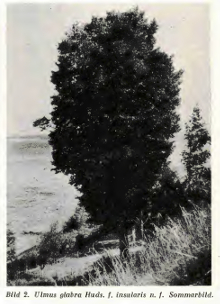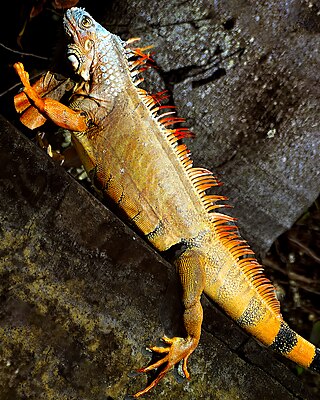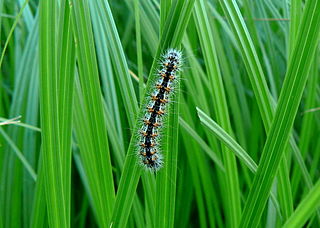
The Socotra sparrow is a passerine bird endemic to the islands of Socotra, Samhah, and Darsah in the Indian Ocean, off the Horn of Africa. The taxonomy of this species and its relatives is complex, with some authorities, including BirdLife International, recognising this species and the very similar Abd al-Kuri sparrow, as well as several from mainland Africa, as separate, and others lumping all these species and the probably unrelated Iago sparrow.

The cultivar Ulmus glabra 'Insularis' [:'island'], the Ven island elm, a fastigiate form of Wych Elm from Sweden, was identified and described by Nilsson in Lustgården 30: 127. 1949, as U. glabraHuds. f. insularis. Nilsson considered it "closely related to subspecies montana(Stokes) Lindqvist". The cultivar arose from a tree on Ven island in Öresund sound, planted c.1900 between Haken and Husvik, possibly from self-sown local seedlings, and approaching 2 m in girth by the late 1940s.

The ochre-collared monarch or rufous-collared monarch is a species of bird in the family Monarchidae. It is found in Yapen and northern New Guinea. Its natural habitats are subtropical or tropical moist lowland forests and subtropical or tropical moist montane forests.

The Lord Howe gerygone or Lord Howe gerygone flyeater was a small bird in the family Acanthizidae, brown and greyish in color. Its head was brown apart from a pale grey eye-ring and a grey throat and chin, many parts of the animal varied to the colour of yellow, this being apparent in its bright yellow belly. It made its home in the canopies of the island's forest until the early 20th century. The bird has had a variety of monikers: locally, it was known as the "rain-bird" due to its activity after the rains, or the "pop-goes-the-weasel", due to the similarity of its song to the well-known tune. The bird was endemic to Lord Howe Island in the Tasman Sea. There have been no records of the species since 1928, and it is considered to be extinct. Its extinction is almost certainly due to predation by black rats which were accidentally introduced to the island in 1918 following the shipwreck of the SS Makambo there.

The Taiwan whistling thrush, also known as the Formosan whistling thrush, is a species of bird in the family Muscicapidae. It is endemic to Taiwan.

Bothrops insularis, commonly known as the golden lancehead, is a highly venomous pit viper species found exclusively on the Ilha da Queimada Grande, off the coast of São Paulo state, in Brazil. The species is named for the light yellowish-brown color of its underside and for its head shape that is characteristic of the genus Bothrops. No subspecies of Bothrops insularis are currently recognized. It is one of the most venomous snakes in Latin America.
The Espíritu Santo antelope squirrel is a species of antelope squirrel in the family Sciuridae. It is endemic to Mexico, where it is known only from the island of Espíritu Santo in the Gulf of California. The species was originally described by Edward William Nelson and Edward Alphonso Goldman in 1909 as a subspecies of the white-tailed antelope squirrel, a wide-ranging species in the southwestern U.S. and Mexico. In 1938, Arthur H. Howell elevated the subspecies to full species status, on the basis of slightly larger skull proportions and the absence or reduction of the third upper premolar. Studies of DNA and chromosomes have variously suggested close relationships with Harris's antelope squirrels or other subspecies of white-tailed antelope squirrel. A 2007 comparison of DNA and morphological traits suggested the differences between Espíritu Santo squirrels and those on the Baja California peninsula and other islands were not enough to warrant distinct species but rather a subspecies of white-tailed antelope squirrels. Since 2008 the IUCN has similarly recognized the Espíritu Santo antelope squirrel as a subspecies of white-tailed antelope squirrel.
The San José Island kangaroo rat is a subspecies of rodent in the family Heteromyidae. It is endemic to Mexico, where it is found only on San José Island off the east coast of Baja California Sur. is restricted to an area of only 30 km2 in the southwestern coast of San José Island, Lower California, with the population having been drastically reduced in size and being close to extinction No other species of Dipodomys occur in sympatry with D. insularis.

The insular mole is a species of mammal in the family Talpidae. It is restricted to Hainan Island and Taiwan, where it is also known as the Formosan blind mole. The species was first described by Robert Swinhoe in 1863.

The Senkaku mole, also known as the Ryukyu mole, is a species of mammal in the family Talpidae. It was formerly classified as being the only species in the genus Nesoscaptor. It is endemic to the Uotsuri-jima of the disputed territory of Senkaku Islands, also known as the Diaoyutai Islands. It is most similar to the Insular mole of Taiwan and Mainland China.

Pteropus pelagicus is a species of fruit bat in the family Pteropodidae. It includes two subspecies that were formerly recognized as full species— Pteropus insularis and Pteropus phaeocephalus. It is endemic to Micronesia. It is threatened by habitat loss.

The black jackrabbit is a species of mammal in the family Leporidae. Endemic to Mexico, its only known location is Espiritu Santo Island in the Gulf of California. The IUCN has listed this species as a "vulnerable species" because of its restricted range. This taxon is regarded by some authorities as being a subspecies of the black-tailed jackrabbit, found on the mainland of Mexico.
Macroperipatus insularis is a species of velvet worm in the Peripatidae family. It may be found in Jamaica, Hispaniola, or Haiti. The original description of this species is based on a female specimen, 55 mm long, with 30 pairs of legs.
Balaka insularis is a rare species of flowering plant in the palm family endemic to Samoa. It was formerly placed in the monotypic genus Solfia with the species name Solfia samoensis. It was placed in the genus Balaka in 2014.

Iguana is a genus of herbivorous lizards that are native to tropical areas of Mexico, Central America, South America, and the Caribbean. The genus was first described in 1768 by Austrian naturalist Josephus Nicolaus Laurenti in his book Specimen Medicum, Exhibens Synopsin Reptilium Emendatam cum Experimentis circa Venena. Two species are placed in the genus, the green iguana, which is widespread throughout its range and a popular pet, and the Lesser Antillean iguana, which is native to the Lesser Antilles. Genetic analysis indicates that the green iguana may comprise a complex of multiple species, some of which have been recently described, but the Reptile Database considers all of these as subspecies of the green iguana.

Arctostaphylos insularis is a species of manzanita known by the common name island manzanita. It is endemic to Santa Cruz Island, one of the Channel Islands of California.

The Bismarck crow is a species of crow found in the Bismarck Archipelago. It was considered by many authorities to be a subspecies of the Torresian crow, but is now treated as a distinct species.

Acronicta insularis, the cattail caterpillar or Henry's marsh moth, is a moth of the family Noctuidae. The species was first described by Gottlieb August Wilhelm Herrich-Schäffer in 1868. It is found from coast to coast throughout the United States and southern Canada.
The Cuban yellow bat is a species of bat from the family Vespertilioninae. It was previously included as a subspecies of the northern yellow bat, a species that has a similar ecology and biology. The species is endemic to Cuba, specifically the Las Villas Province in Cienfuegos, and it is listed under the IUCN Red List as vulnerable due to its ongoing population reduction and relatively small geographic range.

Pterolophia is a genus of longhorn beetles of the subfamily Lamiinae, containing the following species:














